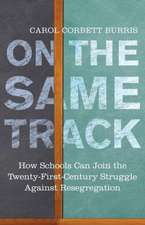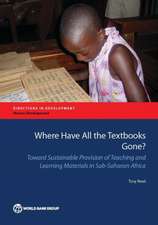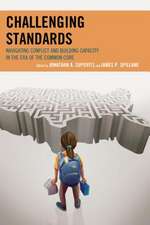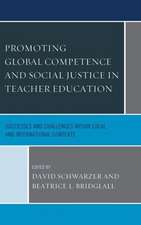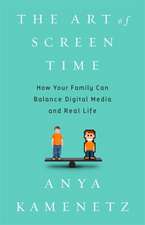Generation Debt: How Our Future Was Sold Out for Student Loans, Bad Jobs, Nobenefits, and Tax Cuts for Rich Geezers--And How to Fight B
Autor Anya Kamenetzen Limba Engleză Paperback – 31 dec 2006
Generation Debt offers a truly gripping account of how young Americans are being ground down by low wages, high taxes, huge student loans, sky-high housing prices, not to mention the impending retirement of their baby boomer parents. Twenty-four-year-old Anya Kamenetz examines this issue from every angle and provides a riveting, rousing manifesto that will inspire everyone to take care of their financial future.
Preț: 135.89 lei
Nou
Puncte Express: 204
Preț estimativ în valută:
26.00€ • 27.20$ • 21.60£
26.00€ • 27.20$ • 21.60£
Carte disponibilă
Livrare economică 13-27 martie
Preluare comenzi: 021 569.72.76
Specificații
ISBN-13: 9781594482342
ISBN-10: 1594482349
Pagini: 308
Dimensiuni: 150 x 208 x 23 mm
Greutate: 0.32 kg
Editura: Riverhead Books
ISBN-10: 1594482349
Pagini: 308
Dimensiuni: 150 x 208 x 23 mm
Greutate: 0.32 kg
Editura: Riverhead Books
Notă biografică
Anya Kamenetz received her B.A. from Yale in 2002 and writes for New York magazine, Salon, The Nation, and The Village Voice, where she earned a Pulitzer Prize nomination for her contributions to the series "Generation Debt: The New Economics of Being Young." She has appeared on the NewsHour with Jim Lehrer as a spokesperson on the employment obstacles facing youth.
Extras
TWO College on Credit
Let our countrymen know that the people alone can protect us against these evils, and that the tax which will be paid for this purpose is not more than the thousandth part of what will be paid to kings, priests and nobles who will rise up among us if we leave the people in ignorance. Preach, my dear Sir, a crusade against ignorance; establish and improve the law for educating the common people.
—Thomas Jefferson, letter to George Wythe, 1786
No qualified student who wants to go to college should be barred by lack of money. That has long been a great American goal; I propose that we achieve it now.
—President Richard M. Nixon, special message to the congress on higher education, 1970
Kids of all backgrounds now aspire to a college diploma. Yet the parchment’s promise to our parents, of a steady middle-class living, goes increasingly unfulfilled for us, replaced by burdens of debt. “Stella,” thirty-one, is one of millions of young people in the United States knocked down by the one-two punch of student loans and credit card debt. Here is her story, in her own words.
I was tired of living at home with Mommy. When I filled out my Free Application for Federal Student Aid [FAFSA], I found out I didn’t qualify for any grants at all, since I was working and they thought I made too much money. I qualified for $5,000 in loans each semester for two semesters. The funny thing is, I only needed about $1,000 to cover the actual schooling. The rest of the money they included was for expenses. Since I had none living at home with Mom, I got it into my young, uneducated brain that I could use the money to move out of her house and become independent.
I don’t need to tell you what a mistake that was...or what easy prey I was for all the credit companies with their tables of free pizza coupons, day planners, gift cards for music stores, T-shirts, and so on. My .rst credit card was a Citibank Visa with a $900 limit, which I maxed by taking a trip to San Diego on my semester break. Duh...
I am now 31 years old and still in debt from those days. Do I still charge to my cards? Yes. But only when I need a car repair or something that my emergency cash reserve won’t cover. I consider bankruptcy every day.
What started out as $10,000 in student loans and about $2,000 in credit card debt has ballooned to a total of $33,000.
But after all this, whom do I blame?
Myself, mostly. My mother (a single mom) next...for not teaching me about money before I took that crazy leap all those years ago. You’d think I would have learned by osmosis, watching her struggle to raise my sister and me. But some people (such as myself) don’t learn just by watching others. Some of us need it spelled out in a lecture.
I cannot save for retirement because I am too busy paying as much over the minimums as I can to the $%#@ cards in hopes that one day I will finally be debt free.
Ironically, I now work for Discover Card. What I know about money and credit now feels like a knife in my back most days. The “Oh, God, I was just like you” feeling hits me so often when I talk to our 18-year-old card members who have exceeded their credit lines and have missed payments. I want to scream at them: “RUN! Next time you see our table on campus, RUN the other way!!” I actually went home and cried recently after I had to spend $711 on a car repair.
I dream of ocean vacations, a good steak dinner, clothing that isn’t faded by numerous washings. I dream of winning the lottery or opening the door to see Dave Sayer, the Publishers Clearing House guy, standing there with the first of many checks. I dream many things, but I can’t do most of them for lack of funds. I hope you reach the right target audience, Anya. If I could help just one person avoid the nightmare that I’m living, I’d consider this e-mail I just wrote you well worth it.
Stella’s debt nightmare speaks to a massive shift in the way our nation finances higher education and thus prepares young people for life. The deal offered to kids has changed in one generation, with little public debate. In 1981, 45 percent of all federal undergraduate student aid dollars came in loans, 52 percent in grants. By the end of the 1990s, the proportion was more than reversed; loans made up 58 percent of federal financial aid, and grants just 41 percent. Nearly two-thirds of the nation’s college students are now borrowing to pay for school. Although the government doesn’t issue an official figure, studies in 2004 and 2005 put the average student loan debt for graduates of four-year colleges between $17,600 and $23,485.
Let our countrymen know that the people alone can protect us against these evils, and that the tax which will be paid for this purpose is not more than the thousandth part of what will be paid to kings, priests and nobles who will rise up among us if we leave the people in ignorance. Preach, my dear Sir, a crusade against ignorance; establish and improve the law for educating the common people.
—Thomas Jefferson, letter to George Wythe, 1786
No qualified student who wants to go to college should be barred by lack of money. That has long been a great American goal; I propose that we achieve it now.
—President Richard M. Nixon, special message to the congress on higher education, 1970
Kids of all backgrounds now aspire to a college diploma. Yet the parchment’s promise to our parents, of a steady middle-class living, goes increasingly unfulfilled for us, replaced by burdens of debt. “Stella,” thirty-one, is one of millions of young people in the United States knocked down by the one-two punch of student loans and credit card debt. Here is her story, in her own words.
I was tired of living at home with Mommy. When I filled out my Free Application for Federal Student Aid [FAFSA], I found out I didn’t qualify for any grants at all, since I was working and they thought I made too much money. I qualified for $5,000 in loans each semester for two semesters. The funny thing is, I only needed about $1,000 to cover the actual schooling. The rest of the money they included was for expenses. Since I had none living at home with Mom, I got it into my young, uneducated brain that I could use the money to move out of her house and become independent.
I don’t need to tell you what a mistake that was...or what easy prey I was for all the credit companies with their tables of free pizza coupons, day planners, gift cards for music stores, T-shirts, and so on. My .rst credit card was a Citibank Visa with a $900 limit, which I maxed by taking a trip to San Diego on my semester break. Duh...
I am now 31 years old and still in debt from those days. Do I still charge to my cards? Yes. But only when I need a car repair or something that my emergency cash reserve won’t cover. I consider bankruptcy every day.
What started out as $10,000 in student loans and about $2,000 in credit card debt has ballooned to a total of $33,000.
But after all this, whom do I blame?
Myself, mostly. My mother (a single mom) next...for not teaching me about money before I took that crazy leap all those years ago. You’d think I would have learned by osmosis, watching her struggle to raise my sister and me. But some people (such as myself) don’t learn just by watching others. Some of us need it spelled out in a lecture.
I cannot save for retirement because I am too busy paying as much over the minimums as I can to the $%#@ cards in hopes that one day I will finally be debt free.
Ironically, I now work for Discover Card. What I know about money and credit now feels like a knife in my back most days. The “Oh, God, I was just like you” feeling hits me so often when I talk to our 18-year-old card members who have exceeded their credit lines and have missed payments. I want to scream at them: “RUN! Next time you see our table on campus, RUN the other way!!” I actually went home and cried recently after I had to spend $711 on a car repair.
I dream of ocean vacations, a good steak dinner, clothing that isn’t faded by numerous washings. I dream of winning the lottery or opening the door to see Dave Sayer, the Publishers Clearing House guy, standing there with the first of many checks. I dream many things, but I can’t do most of them for lack of funds. I hope you reach the right target audience, Anya. If I could help just one person avoid the nightmare that I’m living, I’d consider this e-mail I just wrote you well worth it.
Stella’s debt nightmare speaks to a massive shift in the way our nation finances higher education and thus prepares young people for life. The deal offered to kids has changed in one generation, with little public debate. In 1981, 45 percent of all federal undergraduate student aid dollars came in loans, 52 percent in grants. By the end of the 1990s, the proportion was more than reversed; loans made up 58 percent of federal financial aid, and grants just 41 percent. Nearly two-thirds of the nation’s college students are now borrowing to pay for school. Although the government doesn’t issue an official figure, studies in 2004 and 2005 put the average student loan debt for graduates of four-year colleges between $17,600 and $23,485.
Descriere
Taking a compelling day-to-day look at the life experiences behind a massive economic shift, this rousing manifesto will have readers thinking in new ways about American values and about America's future.





